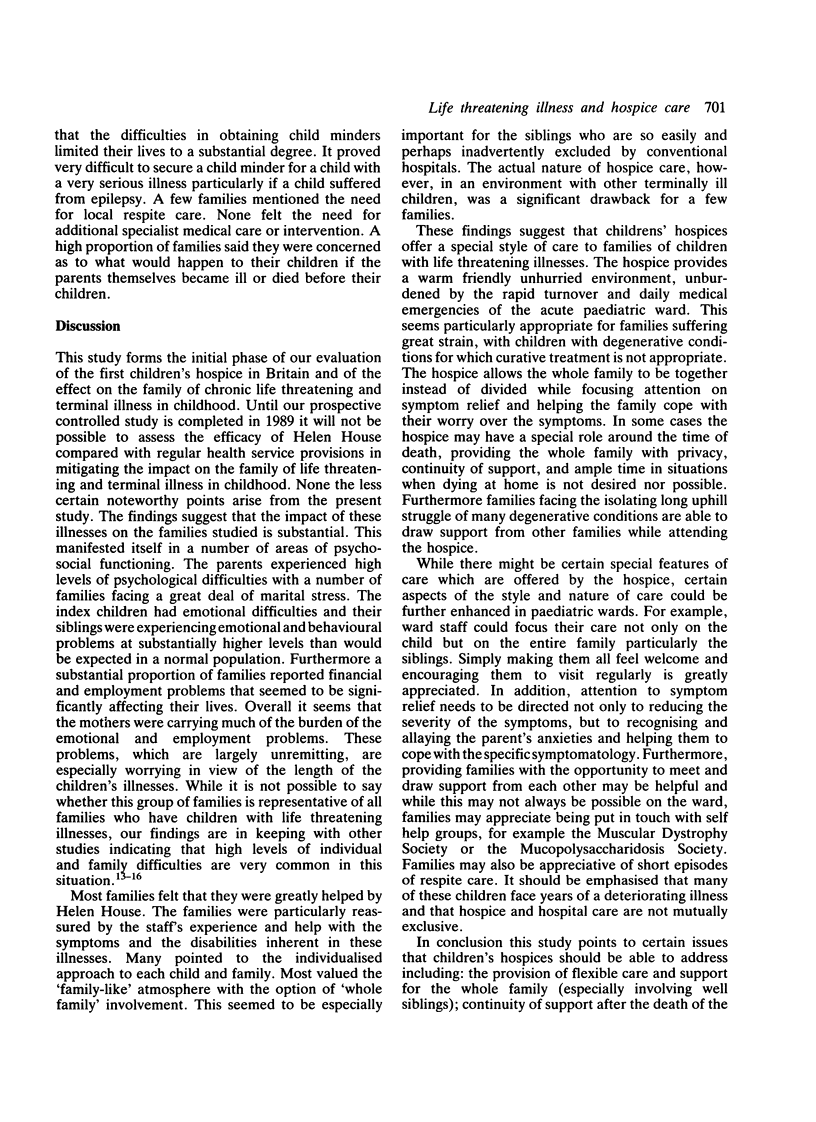Abstract
A retrospective study was undertaken of 25 families and their 26 ill children attending the first children's hospice in the United Kingdom. The study examined the family's perceptions of the care offered and the impact of chronic and life threatening illness. Eighteen (72%) of the families felt they had been well supported by the hospice and valued the family like atmosphere, perceiving the staff to be friendly, approachable, and helpful. The actual nature of hospice care, in an environment with other terminally ill children, was, however, considered a drawback for a few families. A number of families still had unmet needs, notably appropriate child minding when away from the hospice. The impact of chronic life threatening illness on the families was substantial. The parents (particularly the mothers), the index children, and their siblings all experienced much higher levels of psychological symptomatology than would have been expected from normal samples. While families felt greatly helped over symptom control, a proportion remained very worried about certain symptoms, particularly breathlessness, seizures, and pain. A high proportion of families were experiencing financial and employment difficulties as a result of their children's illnesses.
Full text
PDF





Selected References
These references are in PubMed. This may not be the complete list of references from this article.
- Binger C. M., Ablin A. R., Feuerstein R. C., Kushner J. H., Zoger S., Mikkelsen C. Childhood leukemia. Emotional impact on patient and family. N Engl J Med. 1969 Feb 20;280(8):414–418. doi: 10.1056/NEJM196902202800804. [DOI] [PubMed] [Google Scholar]
- Cooper P., Osborn M., Gath D., Feggetter G. Evaluation of a modified self-report measure of social adjustment. Br J Psychiatry. 1982 Jul;141:68–75. doi: 10.1192/bjp.141.1.68. [DOI] [PubMed] [Google Scholar]
- Garralda M. E., Bailey D. Children with psychiatric disorders in primary care. J Child Psychol Psychiatry. 1986 Sep;27(5):611–624. doi: 10.1111/j.1469-7610.1986.tb00186.x. [DOI] [PubMed] [Google Scholar]
- Goldberg D., Kay C., Thompson L. Psychiatric morbidity in general practice and the community. Psychol Med. 1976 Nov;6(4):565–569. doi: 10.1017/s0033291700018183. [DOI] [PubMed] [Google Scholar]
- Parkes C. M. Terminal care: evaluation of in-patient service at St Christopher's Hospice. Part I. Views of surviving spouse on effects of the service on the patient. Postgrad Med J. 1979 Sep;55(646):517–522. doi: 10.1136/pgmj.55.646.517. [DOI] [PMC free article] [PubMed] [Google Scholar]
- Parkes C. M. Terminal care: evaluation of in-patient service at St Christopher's Hospice. Part II. Self assessments of effects of the service on surviving spouses. Postgrad Med J. 1979 Sep;55(646):523–527. doi: 10.1136/pgmj.55.646.523. [DOI] [PMC free article] [PubMed] [Google Scholar]
- Pless I. B., Douglas J. W. Chronic illness in childhood. I. Epidemiological and clinicl characteristics. Pediatrics. 1971 Feb;47(2):405–414. [PubMed] [Google Scholar]
- Pless I. B., Roghmann K. J. Chronic illness and its consequences: observations based on three epidemiologic surveys. J Pediatr. 1971 Sep;79(3):351–359. doi: 10.1016/s0022-3476(71)80141-5. [DOI] [PubMed] [Google Scholar]
- Skegg D. C., Doll R., Perry J. Use of medicines in general practice. Br Med J. 1977 Jun 18;1(6076):1561–1563. doi: 10.1136/bmj.1.6076.1561. [DOI] [PMC free article] [PubMed] [Google Scholar]


